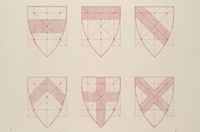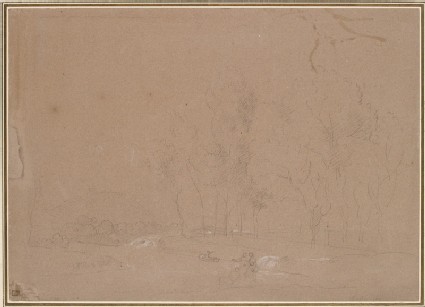Ruskin's revision to the Rudimentary series (1878)
Unpublished manuscript catalogue for proposed re-organisation of the Rudimentary series.

Ruskin's Catalogues: 1 object
Show search help- Reference URL
Actions
Arpinum Richard Wilson
-
Ruskin text
276.Sketch by Richard Wilson, in English low-lands, given to show the state of landscape-art just before Turner broke into it with a new light. Wilson is a thoroughly great Painter and this drawing is not to cast contempt upon him, but upon the kind of teaching which landscapists received in the xviii.th Century. Nor is the sketch given as faultful in manner on the contrary it is wholly exemplary in manner;; it is only faultful in representation of fact: not one of the lines here pretending to represent trees rendering truly any any one fact of stem or foliage, but only recording for the Painter the position of masses which had interested him, and out of which he felt himR. self able to compose an impressive Picture. Of the manner of this composition I shall speak in another place. It is entirely artistic and, in the xviiith century import of the word, gentlemanly in the highest degree, and this quality is one rarely to be obtained in the xixth Century.
-
Details
- Artist/maker
-
Richard Wilson (1713 - 1782)
- Object type
- drawing
- Material and technique
- black and white chalk on pale brown paper
- Dimensions
- 291 x 408 mm
- Inscription
- Recto:
bottom left, a stamp, the letters blank against a black rectangular background: P+S [for Paul Sandby; Lugt 2112]
bottom, towards right, in chalk (Paul Sandby?): Arpinum
- Provenance
-
Paul Sandby
- No. of items
- 1
- Accession no.
- WA.RS.REF.118
-
Subject terms allocated by curators:
Subjects
-
References in which this object is cited include:
References
Brown, David Blayney, Ashmolean Museum Oxford: Catalogue of the Collection of Drawings, iv: The Earlier British Drawings: British Artists and Foreigners Working in Britain Born Before c. 1775 (Oxford: Clarendon Press, 1982), no. 1903
Ruskin, John, ‘Rudimentary Series 1878’, 1878, Oxford, Oxford University Archives, cat. Rudimentary no. 276
Ruskin, John, ‘The Ruskin Art Collection at Oxford: Catalogues, Notes and Instructions’, Edward T. Cook and Alexander Wedderburn, eds, The Works of John Ruskin: Library Edition, 39 (London: George Allen, 1903-1912), 21, cat. Reference no. 118
Location
-
- Western Art Print Room
Ruskin's Catalogues
-
Ruskin's revision to the Rudimentary series (1878)
276.Sketch by Richard Wilson, in English low-lands, given to show the state of landscape-art just before Turner broke into it with a new light. Wilson is a thoroughly great Painter and this drawing is not to cast contempt upon him, but upon the kind of teaching which landscapists received in the xviii.th Century. Nor is the sketch given as faultful in manner on the contrary it is wholly exemplary in manner;; it is only faultful in representation of fact: not one of the lines here pretending to represent trees rendering truly any any one fact of stem or foliage, but only recording for the Painter the position of masses which had interested him, and out of which he felt himR. self able to compose an impressive Picture. Of the manner of this composition I shall speak in another place. It is entirely artistic and, in the xviiith century import of the word, gentlemanly in the highest degree, and this quality is one rarely to be obtained in the xixth Century.





